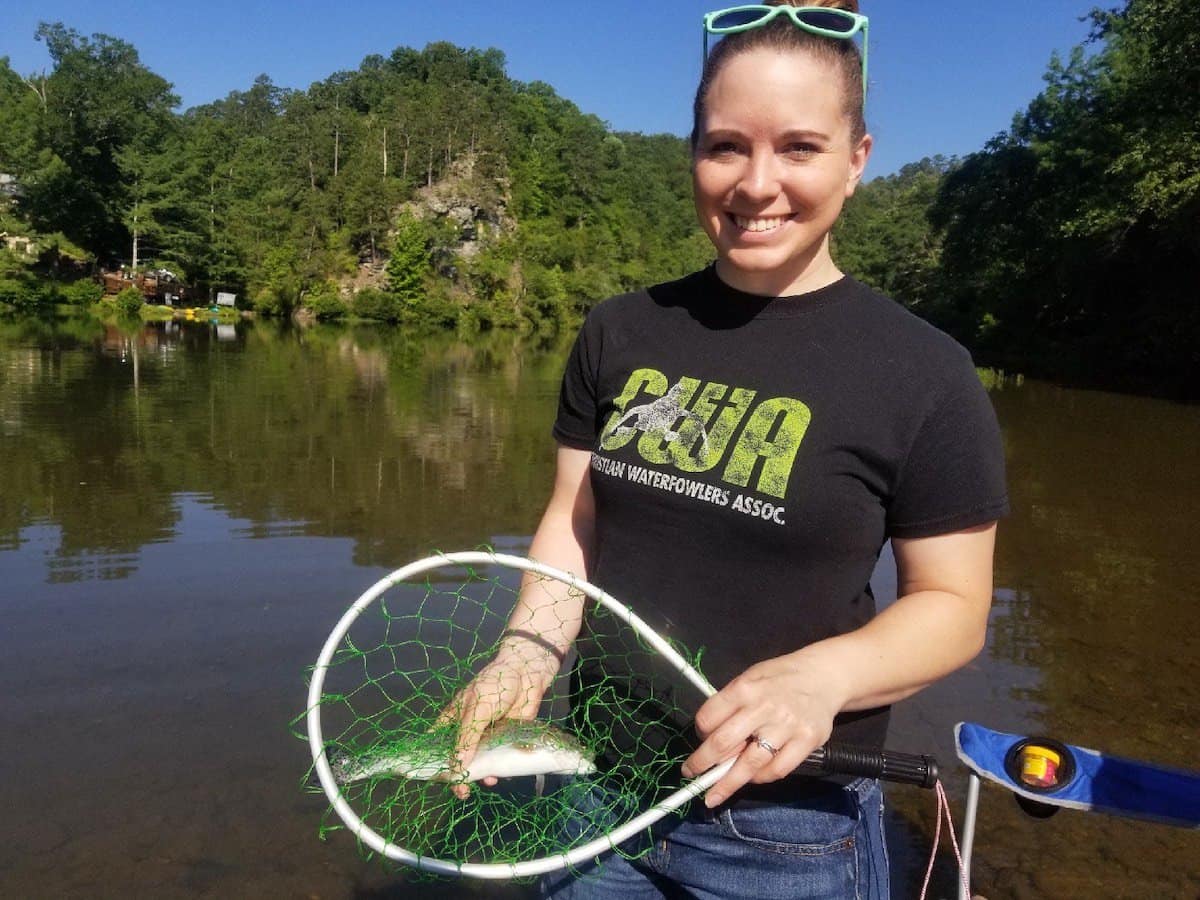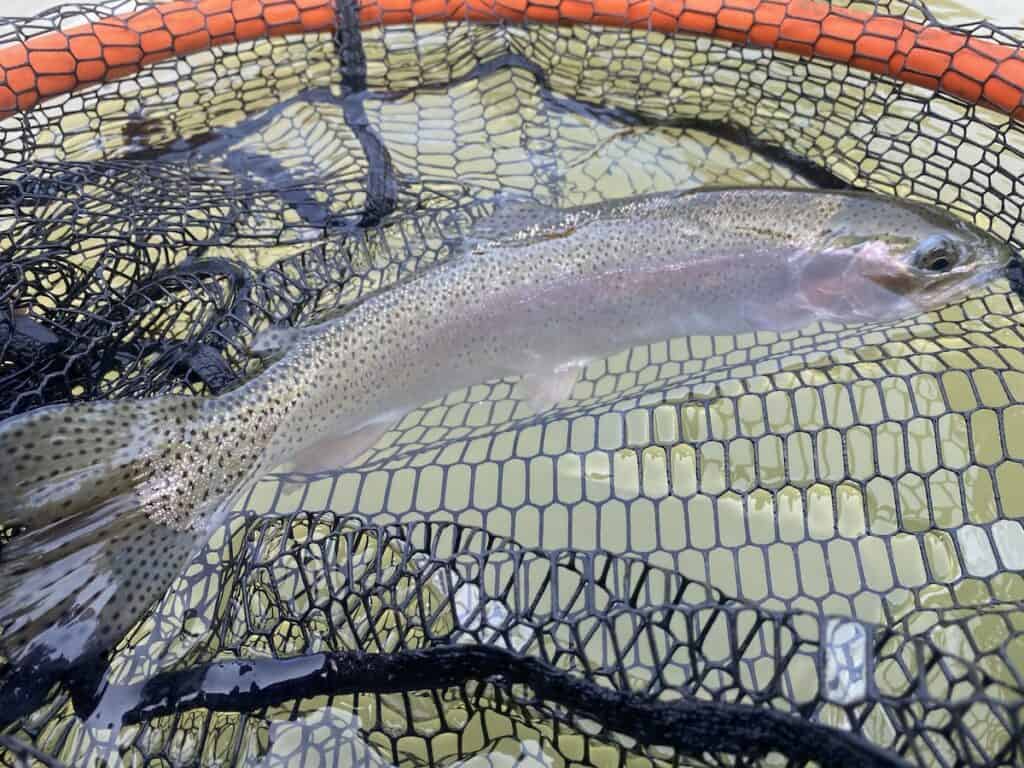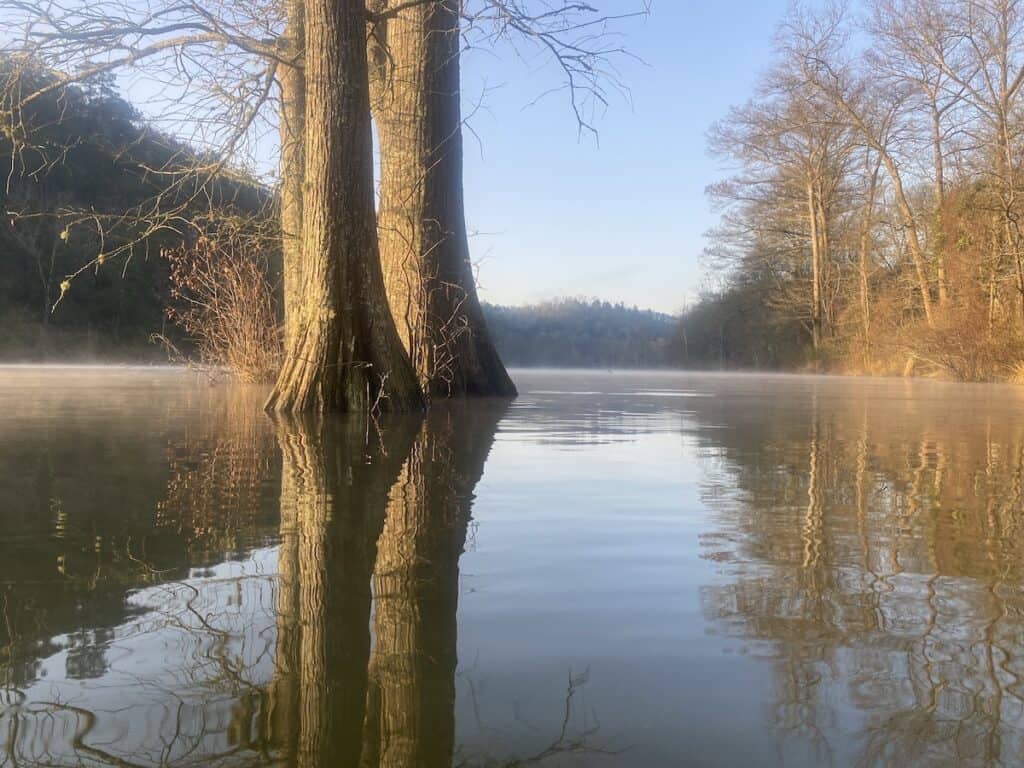Aside from admiring a majestic sunrise in the Ouachita National Forest, trout fishing is the biggest draw to Beavers Bend State Park and the first 12 miles of the Lower Mountain Fork River.
I’ve been to Beavers Bend many times throughout my life, and the following article is some tips and tricks I’ve picked up while trout fishing the Lower Mountain Fork over the years.
Rainbow and brown trout are regularly stocked in the cold waters that flow out of the bottom of Broken Bow Lake, a combination that makes this stream one of the best places to catch trout in Oklahoma.
Check out my YouTube video below to see this fishery in action.
I will also share tips for anyone looking to catch smallmouth bass, walleye or white bass in this river.
Let’s not waste any more time and head to the clean, clear water of the Lower Mountain Fork.
Trout Fishing
In my experience, trout fishing on the Lower Mountain Fork is second to none in Oklahoma.
The Oklahoma Wildlife Department of Conservation (ODWC) stocks rainbow and brown trout throughout the year, so there’s always new fish ready to be caught.
We’re not talking little fish either; plenty of eater-sized and larger fish call this 12-mile stretch of river home. An angler caught a 17-plus-pound brown trout here in 2005 that still holds the state record, so trophy trout are also present in the Lower Mountain Fork.
There is some evidence of naturally reproducing brown trout throughout the stream; however, not enough reproduction occurs to maintain a fishable population, so the ODWC continues to stock brown trout.
That said, rainbow trout are the most common throughout the Lower Mountain Fork and all I have ever personally caught. However, I’ve seen several brown trout hauled in by other anglers.
There is a lot of different water to fish, such as several wide and slow-moving portions, narrower and faster stretches, and everything in between.
Within Beavers Bend State Park, I prefer to fish right below the ripples and rapids of the fast-moving water, as this is where many trout hang out, waiting for their next meal to be swept downriver. Most deeper holes will hold a few trout, especially if boulders or logs also deflect the current.
I’ve caught many fish in the deep hole across the street from the Beavers Bend Fly Shop. The bridge typically has several people fishing on it because this area holds lots of fish. I’ve even had my line snapped by a big fish here.
There are trout throughout the state park; I promise if you find a decent-looking spot, there are trout swimming nearby.
Be sure to be respectful of other anglers, as I’ve always seen other people fishing at Beavers Bend. This fishery is not a secret spot by any means.
Fewer anglers venture downstream, outside of the state park, so if you’re looking for a little more seclusion, I recommend fishing below the Old State Park Dam to the Highway 70 Bridge.
You will need a canoe or kayak to reach some of these lower spots, and some of the rapids are a little technical when paddling and wading.
No matter where you choose to fish along the Lower Mountain Fork, be sure you understand the rules and regulations for the specific area, as there are varying length limits and lure requirements.
You’ll need to wade portions of the river to reach the best spots, so I recommend bringing waders with grippy soles because the water is cold and the rocks are slick.
Let’s discuss the two most common approaches for catching trout.
Lure and Bait Fishing
Because I’m impatient, I often use a spinning rod and reel while trout fishing. I use an ultralight rod and reel, with a 4- to 6-pound test fishing line and tiny barbless trout hooks or lures.
I generally begin with moving lures like Super Duper spoons, in-line spinners, or small crankbaits (all hooks on the lures must be barbless).
I like fishing these types of lures everywhere; however, if you’re using treble hooks, know that they get hung up quite a bit in shallow ripples and brush piles.
If the bite is slow, I’ll switch to using various colors of PowerBait (where it’s permitted). I put a split shot sinker about a foot above my hook and bait to anchor it near the bottom and then wait. I typically use PowerBait in the deeper pools and slower-moving portions of the river.
Both lures and baits work very well in eddies or current breaks, as most predator fish will spend a lot of time here waiting for their next meal.
Fly Fishing
I’m in the minority when trout fishing here because most anglers are fly fishing. The Lower Mountain Fork is one of, if not the prime, fly fishing stream in Oklahoma.
The areas I mentioned above are just as productive for fly fishermen and women, especially when using size 8 Woolly Bugger, size 16 Parachute Adams, 1/80 oz Near Deere Fly, and size 14 Elk Hair Caddis flies.
I recommend stopping by the Beavers Bend Fly Shop to see what patterns anglers have had the most success with lately. When I visit, I always stop by to get the latest scoop on trout fishing.
Trout aren’t the only fish to call these water’s home. I’ve caught a few other species here, often by accident while targeting trout, but they’re worth mentioning.
Bass Fishing
Smallmouth bass are found throughout the Lower Mountain Fork River. While they’re not as abundant in the coldest portions, you’re much more likely to run into a hungry school or two as the water warms downstream.
My approach for river smallies is very similar to trout. I look for current breaks, deep holes, and rapids because bass spend most of their time here.
You’re in for a great time when you can find spots where all three types of structure come together.
I like using swimbaits, spinners, and jigs for river smallmouth. Since the water is clear, I stick with natural shad or bluegill colors.
Walleye Fishing
Quality-sized walleye are pulled from the Lower Mountain Fork annually using swimbaits, jerkbaits, and live minnows.
I recommend walleye fishing during lowlight hours, such as before the sunrises and after the sunsets, because their large eyes are very light-sensitive.
The deep holes just below the ripples and rapids will be your best bet to catch walleye on lures such as crankbaits or jigs or on natural baits where allowed.
Catch More Walleye
White Bass Fishing
The Lower Mountain Fork is home to the Sooner State’s state fish, white bass, or sand bass as we Okies call them.
I’ve caught several, on accident, when using a spoon or Super Duper while trout fishing. However, I rarely complain about catching sandies because they fight hard and are decent-tasting fish.
I use spoons, crankbaits, swimbaits, and crappie jigs in shad patterns when targeting white bass since shad is their primary food source. You’re most likely to find a small sand bass school in the river’s deeper pools.
Planning Your Trip
Now that you’ve learned some of the local fishing knowledge of Beavers Bend and the Lower Mountain Fork, it’s time to begin planning your trip.
I recommend becoming familiar with the public access areas and places to stay.
Public Access Areas
This 12-mile stretch of the Lower Mountain Fork is very accessible. Nearly five miles of the river are located within Beavers Bend State Park, all of which are accessible; just be mindful of campers and other anglers.
Bank access remains unlimited until you reach the re-regulation dam a few miles downriver. Below the dam, there is another public access area at Presbyterian Falls.
Two boat ramps are open to the public. One ramp is above the re-regulation dam, and another is below the dam.
Places to Stay
Whether you’re looking for a lovely weekend of camping or high-end lodging, it’s all available nearby.
Since it’s become a popular tourist destination, you can rent many cabins just outside of Beavers Bend State Park and around the town of Hochatown.
Speaking of Beavers Bend State Park, it’s one of my favorite places to camp because there’s much to do for the whole family.
While you’re staying in the area, you can also check out the fishing at Broken Bow Lake just above the Beavers Bend Dam.



